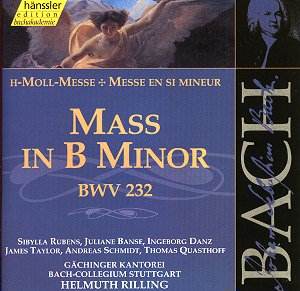Those familiar with Helmut Rilling’s recordings of
Bach’s sacred cantatas, also on Hänssler, will not at all be surprised
at the tone and colours of this recording of Bach’s masterpiece, the
B Minor Mass. Rilling is true to his usual approach, that of using modern
instruments, though the size of his choir (30 singers) is more restrained
than many modern recordings. His performances of Bach’s sacred music
have generally been quite different from such historically-informed
performers as Gustav Leonhardt or Joshua Rifkin, whose recordings of
this work stand as landmarks. However, he points out that he decided,
for this recording, to use a "chamber music ensemble", and,
as always, uses an organ for continuo. (Note that this is Rilling’s
fourth recording of the work, and that he has certainly examined it
more than many conductors, even writing a book on it.)
Rilling begins with a very slow Kyrie; at over 11 minutes,
it is some two minutes longer than both Leonhardt and Rifkin. He is
clearly looking for affekt above all; and he obtains it. The
lush, full sound of the choir, combined with the slow progression of
the melody, carries the listener away into the profound religious sentiment
that this work expresses. Rilling does not, however, maintain these
slow tempi throughout the work; overall, the timing of this performance
matches those of the two HIP recordings mentioned above. But these tempi
can be a bit disturbing. The slow, almost ponderous tone of the Kyrie
eleison gives way to a joyfully rapid Gloria, and the contrast between
these two movements is somewhat jarring. In a way, the energy the Gloria
expresses sounds more real than the density of the movements
played at a slower tempo.
The soloists are all very good - soprano Juliane Banse
is excellent in the Laudamus te, but the other soprano, Sibylla Rubens,
does not have the same presence, and seems a bit in the background in
her two duets. Alto Ingeborg Danz is also very moving and her solo,
Qui sedes ad dextram Patris, is full of profound emotion. The male singers
are just as good, and Thomas Quasthoff has his moment in the limelight
in the Quoniam tu solus Sanctus, which he handles with a fine balance
of force and grace.
One note about the sound: the quality of this recording
is excellent, and one benefits from the magnificent textures apparent
when listening on headphones. However, one also hears the hisses of
sibilants more clearly, which detracts a bit from the magic.
This is a very satisfying recording. Rilling’s sound
here is more agreeable than it is in his cantata recordings, where the
strings tend to overpower the music. With excellent sound, competent
soloists, and impeccable choral movements, this is one of the finest
recordings of the B Minor Mass on modern instruments.
Kirk McElhearn


